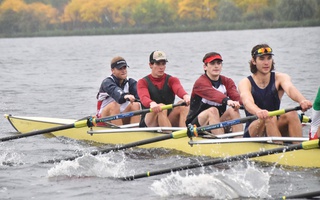{shortcode-9b765631f9f65b375e62b2016f199f2089c8faf6}
It’s that time of year again. The leaves are turning, the air is chilling, the penultimate weekend of October is approaching, and the people are gathering—gathering along the Charles River, that is.
While these occurrences may proceed to proceed like clockwork, what will happen this weekend is far from ordinary. After all, this is the Head of the Charles.
Over the course of two days, close to 400,000 spectators will congregate along the Charles to bear witness, while up to 1,700 volunteers will work behind the scenes. This effort will all revolve around the more than 11,000 athletes who will be compete in 66 different race events for the distinguished title given to the winners: “Head of the Charles.”
Historically, some have referred to the famed regatta as crew’s equivalent of the Boston Marathon, in terms of the event’s magnitude and importance to the sport. Such comparisons are not overreaching, as only the Boston Marathon draws a larger crowd to the city each year. Just for perspective, the Head of the Charles will attract more than three times the spectators this weekend than would a sellout crowd at Gillette Stadium, Fenway Park, and TD Garden combined.
The Head the Charles Regatta is a big deal for more than just the Boston area. The sport as a whole will take notice, as this weekend marks the largest two-day rowing event in the world.
“It's an unparalleled opportunity to compete as an 18- to 22-year-old collegiate athlete against Olympians or world champions, with hundreds of thousands of spectators on your home course,” said senior heavyweight rower Kathleen Malloch.
What has grown to become a globally-renowned event began as a mere idea tossed around by a handful of rowers. At the suggestion of Harvard sculling instructor Ernest Arlett, three co-founders of the Cambridge Boat Club—D’Arcy MacMahon, Howard McIntyre, and Jack Vincent—held the first regatta on October 16, 1965. Holding low expectations regarding attendance, these planners expected the Head of the Charles to function as a break between fall and spring training. Little did these Cambridge men know what their humble race would eventually become an international spectacle.
In the years since 1965, the field of athletes competing has consistently proven to be one of a high caliber. This year will be no exception.
“The competition is fierce,” said co-captain and Harvard heavyweight rower Sofia Donnecke. “The mentality of the athlete is always...at the end of the day, the boat that was willing to fight hardest will come out on top.”
Race entries can take the form of singles, doubles, fours, or eights, and the participants can range anywhere from 14-year-old novices to 85-year-old veterans. The athletes will first take to the water on Saturday, as the weekend will begin with the senior and master divisions for both men and women.
“We're always excited for another opportunity to race,” Malloch said. “Head of the Charles is particularly fun given the caliber of competitors and the size of the audience.”
Progressing into the evening, the championship, alumni, and lightweight groups will see some action. Sunday’s lineup with include mainly youth- and collegiate-level participants. The men’s and women’s championship eights, often considered the most anticipated events, will take place Sunday afternoon.
Harvard’s heavyweight and lightweight teams, both men and women, will compete this weekend. For the Crimson men’s heavyweight team, this weekend marks the first appearance of the fall season.
The men’s lightweight team, along with both the women’s lightweights and heavyweights, made its season debut earlier this month at the Head of the Housatonic regatta in Derby, Conn. Harvard will lean on that experience going into this weekend, as well as on the focused training that the teams have embraced in the previous weeks.
“Now that the Head of the Charles is coming, we are starting to merge into our respective boats for racing,” Donnecke said. “It is always exciting when we start forming crews because it gets each boat amped up to race.”
The Crimson will join competitors from around the world at the Boston University Boathouse to begin the race. The course, which is known for its difficulty, will stretch three miles through five triple-arch bridges. The races toward victory will end just after the Eliot Bridge.
“We are most excited to race against most of the teams who race at Eastern Sprints and the IRA Championships on our home course,” heavyweight captain Conor Harrity said. “It is a great early indicator of our potential for the season. We’ve got a very deep and talented program, and this weekend will be a great opportunity to show our talent in front of a local crowd.”
Read more in Sports
Freshman Rowers Bring International ExperienceRecommended Articles
-
Crew Gets Set for Season's Biggest EventAutumn leaves on the ground. A myriad of boats slicing through pristine water. A massive influx of visitors from far
-
BRIEF: Radcliffe Races Strong Despite Weather Challenges at Head of the CharlesIn the 52nd iteration of the Head of the Charles Regatta, the black and white of Radcliffe Crew topped previous performances facing some of the toughest conditions in regatta history. With tens of thousands of spectators weathering the elements, the crews benefitted strongly from the home field advantage.
-
BRIEF: Sailing Takes Competes at New England Team Race Championship, Emily Wick RegattaThis weekend, the Harvard Sailing team faced off in two regattas—the New England Team Race Championship and the Emily Wick Trophy.
-
Men's and Women's Crew End Season at Foot of the Charles RegattaThis weekend’s sub-freezing temperatures and gusting winds may have signaled the first signs of autumn’s imminent surrender to the Boston winter. A sense of home field advantage was on the side of the Crimson, as the familiar course proved to yield favorable results.
-
 Men's and Women's Crews Prepare for Head of the Charles Regatta
Men's and Women's Crews Prepare for Head of the Charles Regatta













